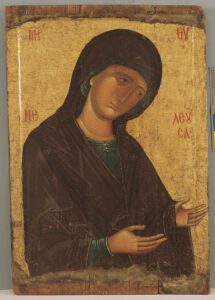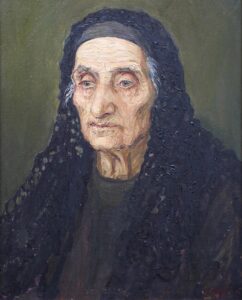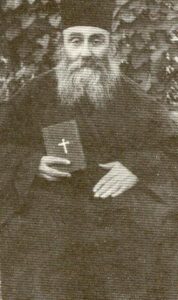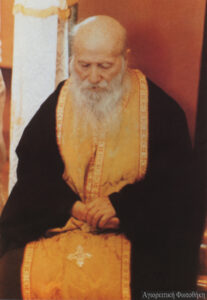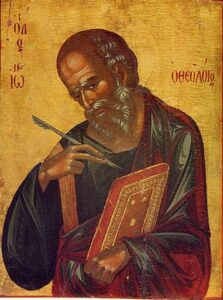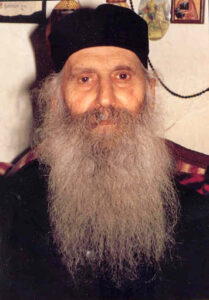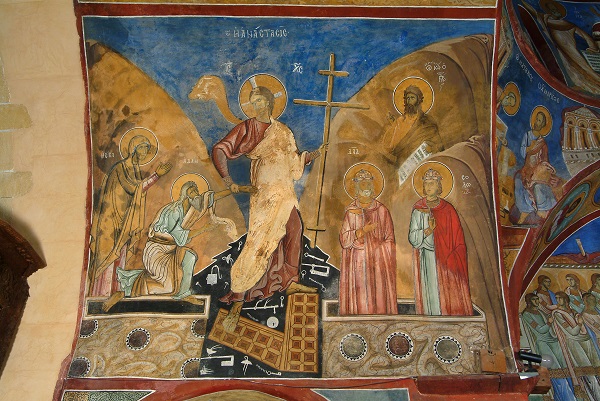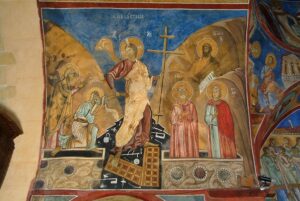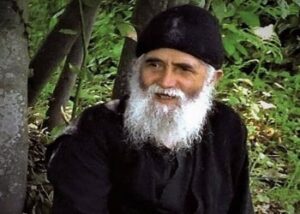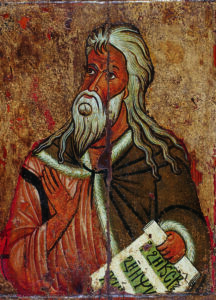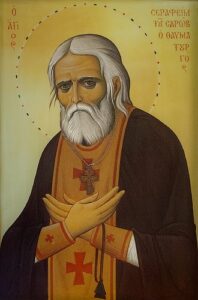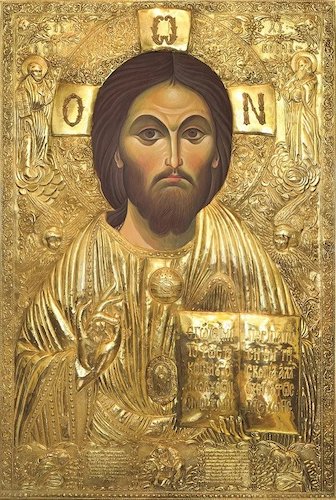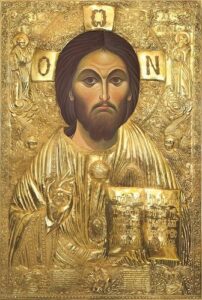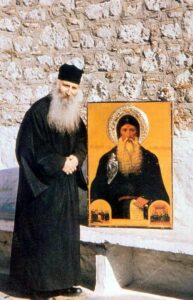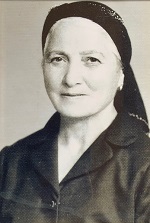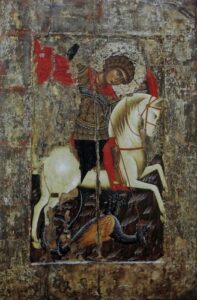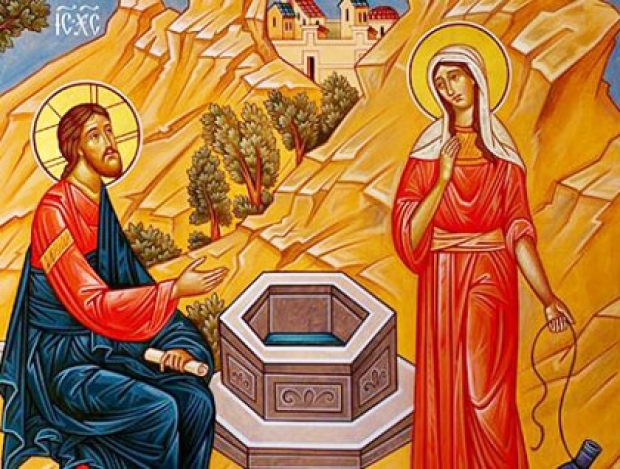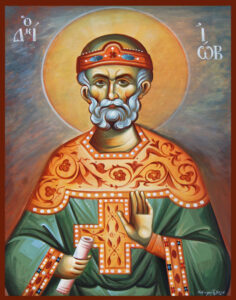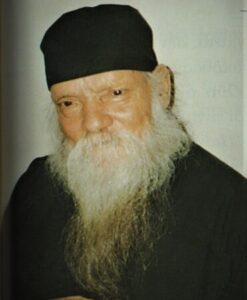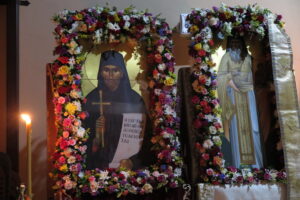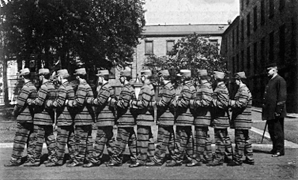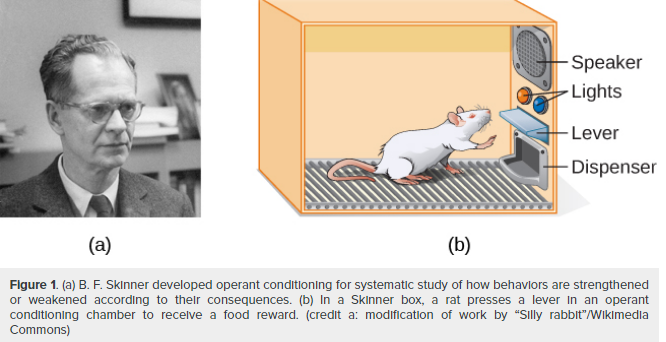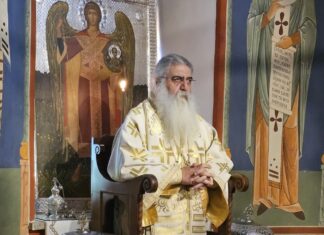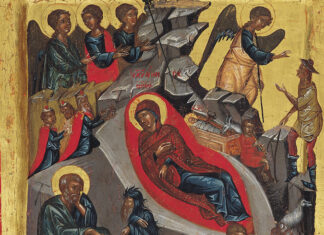
Συνέντευξη Αρχιμανδρίτου Αντώνιου Φραγκάκη, ιεροκήρυκος Ιεράς Μητροπόλεως Γορτύνης και Αρκαδίας, στην άτυπη νεανική ομάδα «Τέκνα Αγίων Δημητρίου, Γεωργίου και Πορφυρίου» Θεσσαλονίκης (10.11.2021).
ΕΡΩΤΗΣΗ: Πανοσιολογιότατε, εξηγείστε μας, σας παρακαλούμε, την έννοια του όρου «υπαρξιακό πρόβλημα», που είναι πάγκοινο γνώρισμα αλλά κυρίως νεανικό ζήτημα.
ΑΠΑΝΤΗΣΗ: Eυχαριστώ πολύ παιδιά για την εμπιστοσύνη και την φιλομάθειά σας. Δεν συνηθίζω να δίνω συνεντεύξεις αλλά με έκαμψε η ευλογημένη επιμονή σας και η θεματολογία των προβληματισμών που μου θέσατε στη συζήτησή μας. Ζητώ συγγνώμη που ενώ υπεσχέθην από τον περασμένο Μάιο καθυστέρησα λόγω της εκδημίας της Γερόντισσας Γαλακτίας. Μεσολάβησε για μένα μία περίοδος μόνωσης και σιωπής. Διαπίστωσα ότι έχετε εύστοχες και υγιείς αναζητήσεις…
Υπαρξιακό πρόβλημα λέγεται κατά τον Όσιο Πορφύριο τον Καυσοκαλυβίτη η διάπυρη λαχτάρα της ψυχής, να συναντήσει το Aρχέτυπο της δημιουργίας της. Απεκάλυψε σε μαθητή του, έτι επιζώντα, ότι την στιγμή της συλλήψεως κάθε ανθρώπου, επιστατεί ο Παράκλητος, το Πνεύμα της Αληθείας, και δημιουργεί εκ του μηδενός την καθαρότατη και αρτιότατη αθάνατη ψυχή. Η ψυχή δεν έχει κληρονομικότητα. Έχει τελειότητα. Τότε, ο νους, ο οφθαλμός της ψυχής, για δευτερόλεπτα ορά τον Χριστό ως Θεάνθρωπο «εν τω Ακτίστω Φωτί»! Μάλιστα, σεβόμενος την ελευθερία ενός εκάστου, ερωτά εκείνη την στιγμή την νεόπλαστη ανθρώπινη ύπαρξη αν θέλει να ζήσει! Την εμπειρία αυτή την μεγαλειώδη και καθοριστική, την διακρατεί η καρδιακή μνήμη του εμβρύου. Συνοδεύει κάθε άνθρωπο σε όλη την εξελισσόμενη επίγεια πορεία του. Δεν ενθυμείται αυτό το γεγονός η μη ανεπτυγμένη εγκεφαλική μνήμη, αλλά η παράλληλη και απείρως δυνατότερη, η επονομαζομένη καρδιακή. Αυτή την διακρατεί μνημονικά ανεξίτηλη και γευστικά απαιτητική. Επομένως, την αναζητά διακαώς σε όλη την μετέπειτα ενδοκοσμική διαδρομή της.
Προσπαθεί με την εμφάνιση των παθών και τις εισηγήσεις του πονηρού να την εντοπίσει στην ικανοποίηση της σωματικής ηδονής και εν γένει στις αισθησιακές απολαύσεις. Στην ψυχαγωγία και τα σπορ. Στην φιλόδοξη αναρρίχηση. Στην υλόφρονα διασφάλιση. Στην επιστημοσύνη και στις ιδεολογίες. Όμως, το κενό ολοένα και περισσότερο μεγεθύνεται και η τραγική αναζήτηση εκτραχύνεται. Οι συνεχείς ανθρωποκεντρικές στοχεύσεις, επιφέρουν και βαθμηδόν θανασιμότερες γεύσεις… Όταν, αποκολληθεί η ψυχή από τα ποικίλα είδωλα της αμαρτίας και συναντήσει τον Χριστό της Ορθοδόξου Μοναδικής Εκκλησίας, τότε ανανεώνει την πρωτόγευστη συγκλονιστική εμπειρία της! Τότε καλύπτεται το εσωτερικό κενό και δίδεται διέξοδος στην οδυνηρή υπαρξιακή αναζήτηση του ανθρώπου. Όλα τα άλλα γήινα που προανέφερα, λησμόνησα τα οινοπνευματώδη ποτά και τις εξαρτησιογόνες ουσίες, ναρκώνουν προς καιρό το νου που βιώνει μια πλασματική ευφορία εν καιρώ επηρείας και καθιστούν ισχυρότερη την βάσανό του, εν καιρώ ανανήψεως… Ισχύει, εδώ, αυτό που έγραψε αρχαίος διδάσκαλος της Εκκλησίας, που δοκίμασε στον ταραχώδη βίο του, αυτήν την αιματηρή αναζήτηση. Πρόκειται για τον Ιερό Αυγουστίνο Επίσκοπο Ιππώνος. Γράφει: «Η ψυχή μας είναι ανήσυχος, έως ότου εύρει ανάπαυσιν εν σοι ω Θεέ…».
Το υπαρξιακό πρόβλημα εκδηλώνεται με αναζητήσεις του τύπου:
- Ποιος είναι ο αληθινός Θεός
- Γιατί με γέννησαν χωρίς να με ρωτήσουν
- Γιατί ο πόνος και ο θάνατος στην ανθρώπινη ύπαρξη
- Ποιος ο σκοπός της γεννήσεως και ο βαθύτερος προορισμός του ανθρώπου
- Υπάρχει πνευματικό στοιχείο μέσα μας; Και αν ναι, σε τί συνίσταται
- Τί συμβαίνει μετά θάνατον κ.α.
Εκδηλώνεται με τέτοια βασανιστικά ερωτήματα και πασχίζει να εκτονωθεί στην ικανοποίηση των παθών και των αισθήσεων. Αυτό διογκώνει αντί να αναπαύει το υπαρξιακό κενό. Σαν να διψάς και να τρέχεις σε βόθρους να ξεδιψάσεις οπότε γίνεται βασανιστικότερη η ανάγκη που σε ώθησε εκεί και επέρχεται και δηλητηριασμός σε όλη σου την ύπαρξη.
Ο γνωστός ηθοποιός Άρης Σερβετάλης, επεξηγώντας σε πρόσφατη τηλεοπτική του συνέντευξη, πως γνώρισε τον Χριστό και έγινε συνειδητό μέλος της Εκκλησίας, αναφέρει τα εξής αποκαλυπτικά: «Είχα βιώσει το χάος… Μέσα στην χαοτική και θυελλώδη αυτή κατάσταση, είχε δημιουργηθεί ένα τραγικό κενό… Αναζητούσα την ηδονή σε οποιαδήποτε μορφή της για να το καλύψω… Επειδή, όμως, είναι εφήμερη, μετά με οδηγούσε σε ένα αβυσσαλέο κενό το οποίο δεν είχε πάτο. Και ένιωθα αυτή τη μοναξιά και έλεγα: Αυτό το πράγμα είναι τερατώδες, δεν μπορώ να το αντέξω. Επομένως, άρχιζα να μην μπορώ να στηριχτώ στον εαυτό μου, όταν βίωσα αυτόν τον πάτο. Τόσο πολύ, που έλεγα ότι δεν υπάρχει κάτι χειρότερο. Άρχισα να ζητώ βοήθεια… Τότε ήρθε ο Χριστός στην ζωή μου! Η ψυχή μου βρήκε αυτό που ζητούσε. Δεν συγκρίνεται με τίποτα…»
Κάποτε ένας νέος ελληνορθόδοξος στην Αγγλία, επισκέφθηκε στην Ιερά Μονή Τιμίου Προδρόμου στο Έσσεξ τον Άγιο Σωφρόνιο. Του είπε συγκλονισμένος: «Γέροντα, πρόσφατα χόρευα με μια κοπέλα σε ένα πάρτι. Και καθώς την φιλούσα στο στόμα, γεύθηκα αίσθηση και ανατριχίλα θανάτου. Γιατί μου συνέβη αυτό;». Ο Άγιος γέλασε και του απάντησε: «Εσύ παιδί μου δεν θα φύγεις ποτέ από την Εκκλησία»! Εξυπονοούσε ο Άγιος Γέροντας, ότι το παλικάρι αυτό διακατέχονταν από μια βαθύτερη υπαρξιακή ανησυχία και αναζήτηση. Νόμισε ότι θα έβρισκε λύτρωση ο βασανισμός της ψυχής του στην ηδονή της σαρκός, αλλά εντόπισε τον θάνατο που φωλιάζει μέσα σ’ αυτές τις εφήμερες επιλογές… Διέγνωσε το ανεκπλήρωτο των ενδομύχων πόθων του και την αστάθεια των ανθρώπινων πραγμάτων. Εν συνεχεία, η αναζήτησή του αυτή θα τον οδηγούσε σε αμεσότερη σχέση με τον Χριστό της Εκκλησίας, οπότε και η σχέση με το άλλο φύλο θα ενταχθεί στην προοπτική της αιωνιότητας. Έτσι θα εδραιωθεί μέσα του η λυτρωτική γεύση από τα στεγανά της κτιστότητας, που εμπεριέχει μέσα της το όπιο του θανάτου και την δουλική υποταγή στις διακελεύσεις της φθαρτότητας. Έλεγε ο Άγιος Σωφρόνιος ότι υπάρχει η χαρισματική μνήμη θανάτου που δημιουργεί το Άγιο Πνεύμα. Τότε βλέπεις τον θάνατο μέσα σου και γύρω σου. Βλέπεις ότι δεν μπορείς να αρδεύσεις πληρότητα εσωτερική από θνητούς. Σαν να πας σ’ ένα νεκροταφείο και να ζητάς εκεί να γίνεις δήμαρχος. Αυτό είναι τρέλα. Το ίδιο αίσθημα δημιουργεί και η χαρισματική μνήμη θανάτου. Διαπιστώνεις ότι δεν εκπληρώνονται από γήινα πράγματα οι βαθύτεροι πόθοι σου, ούτε μπορείς να εξουσιάζεις σε θνητούς. Οπότε, ορμάς στην κατάκτηση της αιωνιότητας. Η χαρισματική μνήμη θανάτου είναι διαφορετική από την πεσιμιστική μνήμη θανάτου που έχει κάθε πανικόβλητος άνθρωπος από ασθένειες, γήρας κλπ. Η χαρισματική μνήμη θανάτου σε οδηγεί στην υπέρβαση του θανάτου και στην κατάκτηση της αιωνιότητας. Αντίθετα η πεσιμιστική μνήμη θανάτου σε υποδουλώνει περισσότερο σ’ αυτόν, γιατί όσο τον ξορκίζεις με ψευδαισθήσεις και γήινες προσκολλήσεις, τόσο απειλητικότερη νοιώθεις την παρουσία του στη ζωή σου.
ΤΗΡΗΣΗ ΤΩΝ ΕΝΤΟΛΩΝ ΤΟΥ ΧΡΙΣΤΟΥ
ΕΡΩΤΗΣΗ: Η Εκκλησία επιμένει πολύ στην τήρηση των εντολών του Χριστού. Κάποιοι νέοι σήμερα, το θεωρούν αυτό δικτατορική επιβολή από ένα σύστημα κωδικοποιημένης ηθικής συμπεριφοράς. Τι θα μας λέγατε πάνω σ’ αυτό;
ΑΠΑΝΤΗΣΗ: Το θέμα των ευαγγελικών εντολών είναι κεφαλαιώδους σημασίας. Δεν είναι ταμπού, ηθικιστικό θέσφατο όπως λένε οι δύο σύγχρονες ενδο-εκκλησιαστικές ακρότητες, οι μεταπατερικοί αμοραλιστές και οι δυτικοτραφείς ευσεβιστές. Είναι βαθύτατα θεολογικό. Είναι θέμα σωτηριολογικής διαχείρισης της θεόπλαστης φύσης μας. Είμαστε εικόνες Θεού. Όχι κρεάτινα είδη που σκέπτονται και αποφασίζουν. Η φύση μας έχει χορηγίες τέτοιες που αν αναπτυχθούν σωστά, κινούμενο με ορμή το αυτεξούσιό μας, (βασικό στοιχείο του κατ’ εικόνα) στην φορά των εντολών του Χριστού, πετυχαίνει την χαρισματική εξομοίωση μαζί Του (καθ’ ομοίωσιν). Αν κινηθεί αντίθετα, εκφυλίζεται η κορυφαία θεϊκή προικοδότηση του αυτεξουσίου, γίνεται προαίρεση, γνωμικό θέλημα και κινείται σε αντίθετη κατεύθυνση, οπότε εκφυλίζεται οντολογικά η υπόσταση του ανθρώπου και ταυτίζεται με τον διάβολο.
Όταν έγινε η Μεταμόρφωση του Χριστού στο όρος Θαβώρ, οι τρείς πρόκριτοι μαθητές Πέτρος, Ιάκωβος και Ιωάννης, είδαν Τρία Φώτα ενιαία. Το Φως που προχέονταν από την ανθρώπινη φύση του Χριστού, την Φωτεινή Νεφέλη που τους επισκίασε και ήταν το Άγιο Πνεύμα και άκουσαν τη φωνή του Ουρανίου Πατρός μέσα από την Νεφέλη να συστήνει και να παραγγέλλει αναφορικά με τον Χριστό. Και η φωνή αυτή, ήταν άκτιστη ενέργεια του Θεού όπως το Φως, καθώς ερμηνεύουν εμπειρικά οι Πατέρες. Τί συνέστησε και τι παρήγγειλε ο Άναρχος Πατήρ, η Πηγαία Θεότης; Φανέρωσε τον Υιόν Του τον αγαπητό, ήτοι τον ενανθρωπήσαντα Λόγο, και συμπλήρωσε τον τρόπο αποδοχής Του, από εμάς τα φθαρέντα δημιουργήματα Του: «Αυτού ακούετε»! Που σημαίνει: Δεν υπάρχει άλλη οδός Θεογνωσίας και Θεοκοινωνίας, εκτός της εφαρμογής των εντολών του Χριστού! Εκείνη τη στιγμή, απευθύνθηκε αντιπροσωπευτικά σε όλη την ανθρωπότητα. Θέλετε, μας είπε να φθάσετε σ’ αυτό το ύψος του υπέρ φύσιν; Αυτό που λέμε Θέωση; Αυτό που συνιστά το ατέλεστον τέλος της υποστατικής σας αρχής; Σ’ αυτό που είναι ο γενεσοποιός σας προορισμός, η αιτία που φανερωθήκατε σ’ αυτόν τον κόσμο; Θα θεραπεύσετε τις τραυματισμένες από το προπατορικό αμάρτημα φτερούγες της ψυχής σας (το προπατορικό αμάρτημα δυνητικά όλοι φέρουμε και υποστατικά καλλιεργούμε) με την σωστή εκκλησιοποίηση, που συνιστά αγώνα υπακοής στις εντολές του Υιού Μου. Αγώνας πνευματικός ονομάζεται και η παράλληλη εξυγίανση των τραυμάτων της αμαρτίας με την ουσιαστική μετάνοια και την επαναφορά του νου στην φυσική του στοχοθεσία με την έμπνευση και την προσπάθεια. Αυτό λέγεται άσκηση. Ησυχασμός. Εμείς κάνουμε ένα βήμα με τον φυσικό, τον σωστό προσανατολισμό του αυτεξουσίου μας και ο Χριστός κάνει έπειτα ενενήκοντα εννέα και χορηγεί χαρισματικά την ολοκλήρωση του αναγεννητικού μας εγχειρήματος. Έπειτα γλυκαίνεται ο νους και αναπτύσσει πυραυλική επιτάχυνση στην κατεύθυνση της αρχέγονης επικοινωνίας. Στην αναγωγή προς τον Θεό. Φυλάσσουμε το κατά φύσιν, φεύγουμε το παρά φύσιν και ολοταχώς κινούμεθα προς το υπέρ φύσιν. Αυτό αναφέρει ένα τροπάριο της υμνολογίας μας για τον Τίμιο Πρόδρομο. Παρόμοια κινήθηκαν και όλοι οι Άγιοι. Ανέπτυσσαν ασκητικά και ησυχαστικά το φυσικό τους θέλημα και το αποτέλεσμα ήταν η συνεχής αφομοίωση ακτίστων δωρημάτων, που τους έκανε να υπερβαίνουν και τους νόμους της φύσεως όπως π.χ. οι τρείς παίδες στην κάμινο του πυρός. «Επειδάν ημείς πράξωμεν όσα δυνάμεθα, τότε ο Θεός εκτείνει την παντοδύναμον χείρα της βοηθείας Του».
Χρειάζεται λοιπόν, θεραπεία, μας λέγει ο ουράνιος Πατέρας, μέσα στο νοσοκομείο του Υιού Μου, με φάρμακο την εφαρμογή των εντολών Του! Ειδικά εκείνης «Λάβετε φάγετε…πίετε εξ’ Αυτού πάντες». Οι εντολές αυτές δεν είναι νομικά σχήματα σαν αυτά που εφαρμόζουν οι κρατικές αρχές. Δεν θα έχει, δικανικού τύπου συνέπειες η παράβαση τους, όπως γίνεται από τα σωφρονιστικά όργανα της πολιτείας. Είναι φάρμακα ζωής. Και τί ζωής! Ζωής αιωνίου! Ή κάνεις σωστή χρήση των εντολών του Χριστού, θεραπεύεσαι, φθάνεις μόνιμα στο θαβώρειο ύψος και τελειούσαι, ή τις περιφρονείς και δέχεσαι τις εισηγήσεις του διαβόλου. Οπότε απομακρύνεσαι από την πηγή της ζωής, νεκρώνεσαι πνευματικά από την νεκροποιό δράση του νεκρού πνεύματος που σε παραλαμβάνει και δοκιμάζεις από την παρούσα ζωή την κόλαση που είναι η ενεργοποίηση των δικαιωμάτων του διαβόλου εις βάρος σου. Αυτό συνιστά και την έναρξη της μόνιμης απωλείας σου…
Βέβαια, μια διευκρίνηση, χωρίς ιδιαίτερες προσεγγίσεις, για να μην μακρηγορήσουμε.
Η επιφανειακή χρήση των θείων εντολών χωρίς εσωτερική συγκατάθεση και βίωμα καρδιακό, καταντά στείρα ιδεοληψία και οδηγεί σε φονταμενταλιστικές ακρότητες με ευσεβίστικο επίχρισμα. Αυτό λέγεται εκνομίκευση. Είναι προσδιοριστικό στοιχείο κυρίως του Παπισμού… Η απόρριψη πάλι των εντολών με πρόσχημα το περσοναλιστικό σύνθημα, «ζήσε με αγάπη και ελευθερία», οδηγεί στην κατοχύρωση των παθών, στην αναγόρευση της αισθησιακής ηδονής ως κινητήριας δύναμης για την αναγωγή στο Θείο και στην αντικατάσταση της Θέωσης με την τάχα χαρακτηρολογική βελτίωση και την συναισθηματική διαπροσωπική αλληλοσύνδεση… Και αυτή, βέβαια, την καμουφλαρισμένη ανθρωπολογία, την «καταξιωμένη» ουμανιστικά με «ελεύθερη» κατά τα άλλα και αγαπολογική μεθοδολογία, την εντάσσουν σε απολύτως επιλεγμένα πλαίσια που θεωρούν ότι δεν βλάπτουν τον συνάνθρωπο. Αυτό δηλαδή που νεκρώνει την ψυχή, με την φθοροποιό αυτοδιάθεσή της στις εμπαθείς παρορμήσεις της, ονομάζεται ελευθέρα ανάπτυξη των ουσιωδών ποιοτήτων του ανθρωπίνου είναι, μια και θεωρούνται τα ψεκτά πάθη, αξεπέραστες και επιβεβλημένες φυσικές αναγκαιότητες και όχι εμπαθείς υποστατικές προτιμήσεις που χρήζουν θεραπείας… Καλλιεργούν την φιλαυτία με την προσχηματικά «αγαπητική» θεώρηση των συνανθρώπων τους, που τους εκλαμβάνουν ως μέσα ηδονοληψίας και χρηστικής ιδιοχειρίας. Έτσι, ενώ βυθίζονται στο έρεβος του υποκόσμου, βαυκαλίζονται αυταρκούμενοι στον διεστραμμένο ναρκισσισμό τους, ότι καλλιεργούν και τον Θείο έρωτα..! Αυτό λέγεται αντινομισμός και είναι ίδιον των προτεσταντικών ομάδων και των μεταπατερικών – αγαπουλιστών που κατέκλυσαν σήμερα τον τόπο μας…
Κατακλείω την απάντηση, με τον τόσο παραστατικό και ζωοπάροχο λόγο του Κυρίου μας: «ὁ ἔχων τὰς ἐντολάς μου καὶ τηρῶν αὐτάς, ἐκεῖνός ἐστιν ὁ ἀγαπῶν με· ὁ δὲ ἀγαπῶν με ἀγαπηθήσεται ὑπὸ τοῦ πατρός μου, καὶ ἐγὼ ἀγαπήσω αὐτὸν καὶ ἐμφανίσω αὐτῷ ἐμαυτόν… ἐάν τις ἀγαπᾷ με, τὸν λόγον μου τηρήσει, καὶ ὁ πατήρ μου ἀγαπήσει αὐτόν, καὶ πρὸς αὐτὸν ἐλευσόμεθα καὶ μονὴν παρ᾿ αὐτῷ ποιήσομεν.» (IΩAN. IΔ’, 21-24).
ΤΑ ΑΙΤΙΑ ΤΗΣ ΟΜΟΦΥΛΟΦΙΛΙΑΣ
ΕΡΩΤΗΣΗ: Σας παρακαλούμε, Πάτερ, αναπτύξετε την άποψή σας για τα αίτια της ομοφυλοφιλίας και τις προγαμιαίες σχέσεις. Είναι θέματα που απασχολούν πολλούς φίλους μας.
ΑΠΑΝΤΗΣΗ: Η άποψή μου δεν μπορεί να είναι διαφορετική από την διαχρονική τοποθέτηση των θεουμένων, πάνω στα καυτά και μυριοσυζητημένα αυτά θέματα. Κατ’ αρχάς, το μεγάλο πρόβλημα της ομοφυλοφιλίας, από γενετικής πλευράς, δεν είναι ορμονικό. Μπορεί σε κάποιους άνδρες να είναι κάπως μειωμένη η βασική ανδρική ορμόνη που λέγεται τεστοστερόνη ή αντίστοιχα τα οιστρογόνα των γυναικών. Αυτό είναι βέβαια σπάνιο και όχι πάντως αίτιο ομοφυλοφιλίας. Αυτές είναι οι βασικές ορμόνες που δημιουργούν τα όργανα και τους ενδοκρινείς αδένες. Αν π.χ. ένας άνδρας έχει κάπως μειωμένη τεστοστερόνη, μπορεί να μην έχει πλούσια τριχοφυΐα, να έχει ελάττωση της μυϊκής και οστικής μάζας, κοπιώδη συμπεριφορά αλλά όχι ομοφυλοφιλική τάση. Το ίδιο και σε αντίστοιχες περιπτώσεις γυναικών. Το διευκρινίζω αυτό, γιατί η περσοναλιστική – μεταπατερική προσέγγιση του φαινομένου, θεωρεί την ομοφυλοφιλία αναγκαιότητα της φύσεως λόγω ορμονικών διαταραχών και άλλων γενετικών παραγόντων. Άρα η υπαιτιότητα της φρικτής αυτής ιδιαιτερότητας ανάγεται στον Δημιουργό και αθωώνει τον άνθρωπο για την ανάπτυξη της «φυσικής» του ορέξεως, αφού τάχατες την φέρει αναγκαστικά και αδυνατεί να αλλάξει τον σεξουαλικό του προσανατολισμό, όπως δεν μπορεί να αλλάξει και το χρώμα των οφθαλμών του! Μέγιστη βλασφημία! Η ομοφυλοφιλία δεν είναι φυσική προικοδότηση αλλά δαιμονική υποβολή. Είναι πάθος, το πιο ειδεχθές και αποκρουστικό και οφείλεται σε γνωμική μετάλλαξη του ανθρώπου που το καλλιεργεί και όχι σε ουσιώδη ποιότητα της φύσεώς του. Βεβαίως, υπάρχουν στοιχεία υποδομής που μπορεί να δημιουργήσουν «φθόνω και συνεργεία του διαβόλου» αυτή την φρικώδη παρέκκλιση από την θεόθεν παραδεδομένη λειτουργία της φύσεώς μας.
Αρχικό στοιχείο είναι η αχαλίνωτη σαρκολατρεία! Το σύνθημα του πανσεξουαλισμού: «Όλα επιτρέπονται! Χαρείτε τον «έρωτα» με οποιοδήποτε τρόπο και οποιοδήποτε πρόσωπο. Απολαύσατε την ολοκληρία της ευτυχίας, στην αγαπητική σεξουαλική κατάφαση οποιουδήποτε σώματος»! Όταν ο άνθρωπος μυηθεί σ’ αυτή την αχαλίνωτη τακτική, ζει συνεχώς μια αφόρητη και επαυξανόμενη κόλαση. Συνεχώς αναζητά καινούργιες σαρκικές εμπειρίες για να καλύψει το εσωτερικό του κενό και να κατασβέσει την φλογώδη βάσανο της ψυχής του, που ολοένα και θεριεύει, ακριβώς, επειδή δεν τρέφεται η ψυχή απ’ αυτές τις σαπρώδεις «αγαπητικές» γεύσεις, ούτε καλύπτεται η υπαρξιακή αναζήτηση του ανθρώπου με αυτές τις υποκτηνώδεις επιλογές. Συνεχίζεται, τοιουτοτρόπως, η καλπάζουσα ζοφερή δαιμονοποίηση, που επιφέρει νομοτελειακά και επαυξανόμενη παραφυσική επίδοση… Όσο ταυτίζεσαι με τον διάβολο, τόσο μυείσαι στο παρά φύσιν. Είναι παράλληλες ή μάλλον ταυτόσημες οι έννοιες αυτές. Ο διάβολος είναι ο πατέρας της διαστροφής. Διέστρεψε την φύση του και από φωτεινός και αγλαόμορφος άγγελος, έγινε σκοτεινός και αποτρόπαιος δαίμονας. Χαίρεται να διαστρέφει και τα άλλα λογικά πλάσματα του Θεού, αυτό συνιστά ίσως την μοναδική χαρά του, για να ακυρώνει το έργο της εκκλησίας, που αποβλέπει στην αναγωγή της ψυχοσωματικής ολότητας του ανθρώπου στο υπέρ φύσιν. Αυτό συντελείται , με τις δικές του διαβρωτικές εισηγήσεις για κάθοδο στο παρά φύσιν! Το επιχειρεί τούτο, σε όλα τα επίπεδα της ανθρώπινης φυσιολογίας, πολύ περισσότερο στην επιθυμία που είναι και η δυνατότερη ιδιότητα του ανθρώπου. Έτσι γεννάται γενικότερα η αμαρτία, όπως αναφέρει επιγραμματικά ο Άγιος Ιωάννης ο Δαμασκηνός: «αμαρτία εστί η εκ του κατά φύσιν εις το παρά φύσιν εκουσία παραδρομή»! Το πάντρεμα λοιπόν με το διάβολο, αφηνιάζει όλο και περισσότερο τον διεστραμμένο ανθρώπινο νου. Συνεχώς αναζητά νέες τέρψεις και αισθησιακές προσκολλήσεις, αλλά πληρότητα και ικανοποίηση δεν βρίσκει πουθενά…
Όταν, λοιπόν, αφεθεί ελεύθερος ο άρρωστος νους του ανθρώπου, στην φιλοπερίεργη αναζήτηση των ηδονών, τότε καταλήγει ανώμαλος, κτηνοβάτης κλπ. Πόσοι άνθρωποι δεν αηδιάζουν τον εαυτό τους, όταν φωτισθεί ο νους τους μέσα από το μυστήριο της εξομολογήσεως και μας λένε σπαρακτικά: θέλω να βγάλω από πάνω μου τούτες τις σάρκες γιατί τις σιχαίνομαι και να βάλω καινούργιες στη θέση τους… Καλύτερα να πέθαινα, παρά να έκανα, όσα έκανα…
Την παραφυσική αυτή διαδρομή και εξέλιξη της αχαλίνωτης ηδονής, την τονίζει και ο Άγιος Γρηγόριος ο Παλαμάς: «νους αποστάς του Θεού ή δαιμονιώδης γίνεται (με την υπερηφάνεια), ή κτηνώδης (με την σαρκολατρεία). Και των όρων αποστήσας της φύσεως επιθυμεί των αλλοτρίων. Ταις σαρκικαίς ηδοναίς έκθετον εαυτόν ποιεί… Από ηδονής πορεύεται εις ηδονήν και μέτρον ηδονής ου γινώσκει». Οπότε όσο κερδίζει έδαφος ο διάβολος σε μια ψυχή, τόσο διαστρέφεται το τριμερές της οντολογίας της (θυμικό, επιθυμητικό, λογιστικό) γιατί ηγεμονεύει αφηνιασμένος νους και είναι αναπόδραστη η επαυξανόμενη βύθιση στα σοδομιτικά τέλματα…
ΤΟ ΠΡΟΒΛΗΜΑ ΤΗΣ ΟΜΟΦΥΛΟΦΙΛΙΑΣ ΕΙΝΑΙ ΘΕΟΛΟΓΙΚΟ-ΠΝΕΥΜΑΤΙΚΟ
Το πρόβλημα επομένως της ομοφυλοφιλίας είναι καθαρά θεολογικό – πνευματικό. Υποκινείται και από προγενετικές και μεταγενετικές επιδράσεις στην ψυχή των παιδιών από το περιβάλλον που ζουν. Αν π.χ. κυοφορεί η μάνα αγόρι και επιθυμεί έντονα κορίτσι, αν του συμπεριφέρεται σαν να είναι κορίτσι, αν οι γονείς μετέδωσαν διεστραμμένο πνευματικό γονιδίωμα στα παιδιά τους από τον τρόπο της δικής τους συζυγικής ζωής, αν η μάνα είχε βασανιστικό ρόλο μέσα στο σπίτι έναντι του αδύνατου ηγετικά πατέρα και των παιδιών, οπότε, αναπτύσσεται μισογυνισμός και αισθηματική στροφή προς το ίδιο φύλο, αν έβλεπαν οι γονείς διεστραμμένες ταινίες και μετέδωσαν επαγωγικά αυτές τις επιδράσεις στα παιδιά τους, αν άφηναν τα παιδιά να διαμορφώνουν αντίληψη για την ζωή και την κοινωνία με βασικό παιδαγωγικό συντελεστή τα διεφθαρμένα πρότυπα της τηλεθέασης, αν υπήρχαν παιδικοί βιασμοί, κόμπλεξ κατωτερότητος στερημένων παιδιών έναντι άλλων κλπ…
Βασική αιτία του καλπασμού της ομοφυλοφιλίας σήμερα, είναι οι συζυγικές παρεκκλίσεις από την φυσιολογικότητα και αλλοίωση του DNA από τις αποτυπώσεις παραφυσικών σφραγίδων… Η ψυχή αφήνει τα δελτία της, τις ράγες της κινήσεώς της, τις γραμμώσεις της συμπεριφοράς της πάνω στους θύλακες του βιολογικού γονιδιώματος. Αυτό λέγεται πνευματικό DNA. Δεν είναι ίδιον της φύσεως, που μεταδίδεται αναγκαστικά στην γενετική τους παραγωγή. Είναι ροπές και προτάσεις ζωής, που επεξεργάζεται μυστηριωδώς η προαίρεση από την εμβρυακή ηλικία και καθώς προηγείται της νοήσεως, υιοθετεί πανεύκολα, ό,τι πνευματικό κληροδότημα «φωσφορίζει», ήτοι ξεχωρίζει έντονα πάνω στο γενετικό υλικό! Αυτό αργότερα διορθώνεται με μετάνοια και αγώνα. Είναι επιλογή επαναλαμβάνω. Όχι αναγκαιότητα. Οπότε, αν δεν θέλουν να δουν οι γονείς τα παιδιά τους σ’ αυτό το στάδιο, να προσέχουν οι ίδιοι, προγενετικά ακόμη, τι υλικό και τι ερεθίσματα τους κληροδοτούν. Να προσέχουν, πώς ζουν οι ίδιοι, όταν είναι σε εμβρυακή κατάσταση τα παιδιά τους και σε τι ατμόσφαιρα τα ανατρέφουν..
ΠΡΟΓΑΜΙΑΙΕΣ ΣΧΕΣΕΙΣ
Υπό ανάλογο πρίσμα βλέπει η Εκκλησία και αξιολογεί και τις προγαμιαίες σχέσεις. Δεν υπάρχει «επιτρέπεται – απαγορεύεται» υπό την δικανική έννοια του όρου, αλλά τί ωφελεί τον άνθρωπο και τί τον βλάπτει. Τι τον θεραπεύει και υγιή πνευματικά τον προσαγάγει στο Χριστό και τί τον απομακρύνει απ’ αυτόν, τον αρρωσταίνει περισσότερο και τον εντάσσει σε αντίθετη πορεία. Ήτοι, τί τον ταυτίζει με τον διάβολο.
Η ένωση ανδρός και γυναικός κατά το θέλημα του Θεού, άρχεται πρωτίστως από ψυχικό-καρδιακό επίπεδο και καταλήγει στο σωματικό. Είναι μυστηριακό γεγονός και μάλιστα μεγίστης σημασίας η ένωση «εις σάρκα μίαν» ενός ανδρογύνου. Ξεκινά φιλότιμα η προσπάθεια, με κίνητρο αυτό που λέμε, ερωτική προσκόλληση αλλά η καρδιακή συνταύτιση δεν επιτυγχάνεται μόνο μ’ αυτό. Χρειάζεται και την Χάρη του Θεού. Οπότε, με την ιερολογία του γάμου, το Πνεύμα το Άγιο, αυτό που ξεκινούν μόνοι τους οι μεμνηστευμένοι και δεν μπορούν να ολοκληρώσουν, το επιτυγχάνει η δύναμις του μυστηρίου. Δύο ψυχές σ’ ένα ενιαίο και αδιάσπαστο σκεύασμα αγάπης. Η καρδιακή αγάπη είναι κάτι βαθύτερο και καθαρότερο από την συναισθηματική. Είναι απαλλαγμένη από κάθε στοιχείο φιλαυτίας και εξωτερικεύεται με την αρμονία και θυσία. Όταν αγαπάς σωστά, υποχωρείς, υπομονεύεσαι, συγχωρείς, προτάσσεις τις καλές επιθυμίες του άλλου έναντι των δικών σου. Αυτή η καρδιακή αρμονία, εξωτερικεύεται με την σωματική αρμονία. Συνευρίσκονται σαρκικά τα ανδρόγυνα και αισθητοποιούν ο ένας στον άλλο την εσωτερική αγάπη που τρέφουν επ’ αλλήλους. Ό,τι αγαπάς το σέβεσαι, δεν το εκχυδαΐζεις, δεν το ευτελίζεις, δεν το βασανίζεις, δεν το προδίδεις. Η σωματική αρμονία πηγάζει από την ψυχική αρμονία και έχει ορμέμφυτους κανόνες συμπεριφοράς. Όταν, τώρα, δεν υπάρχει αυτή η σωτήρια επίδραση του μυστηρίου του γάμου, τότε η ανθρωποκεντρική αγάπη, όσο καλοδιάθετα κι αν ξεκίνησε, είναι αδύνατον να αυξηθεί και να γίνει καρδιακή αλληλοπεριχώρηση. Εκεί λειτουργεί αφεύκτως η φιλαυτία με τρόπο έκφρασης την ιδιοτέλεια. Ερωτεύονται παράφορα και μετά από λίγο χωρίζουν. Γιατί; Γιατί ο καθένας αγαπά κατ’ ουσίαν τον εαυτό του και τα πάθη του και πασχίζει να τα ικανοποιήσει μέσω του άλλου, τον οποίο εκλαμβάνει ως εργαλείο εκτόνωσης και σκεύος ηδονής. Όχι, ως φυσικό του συμπλήρωμα, για να πετύχει την ψυχοσωματική του ολοκλήρωση και συνδρομή στη σωτηρία.
Οπότε, στις σχέσεις αυτές, πορνείας, μοιχείας κ.λπ. δεν λειτουργεί η ανιδιοτελής αγάπη με τρόπο έκφρασης τον σεβασμό και την αξιοπρέπεια αλλά η βία και η λαγνεία. Ο άρρωστος ψυχισμός εξωτερικεύεται με την σωματική εκμετάλλευση, γιατί όχι και την βρώμικη παραχρησία προκειμένου να καλοπεράσει η φιλαυτία. Αυτή η βία είναι αμφίδρομη σχέση. Ό,τι γίνεται με φιλαυτία εις βάρος του άλλου, επιστρέφει επαυξημένη στον βιαίως ενεργούντα με αυτό το κίνητρο, έστω και αν προς στιγμήν την ανέχεται για λόγους ευτελείς και χρησιμοθηρικούς. Τότε ο υποκινητής διάβολος που διαφεντεύει ανάμεσά τους αυτή την σχέση, αγριεύει την βιαιότητα όλων των ψυχικών παραγόντων, αμφοτέρων των εμπλεκομένων και τα κάνει στο τέλος όλα «Βιετνάμ» κατά το κοινώς λεγόμενο. Οι τρελά ερωτευμένοι, επειδή δεν είχαν ανάμεσά τους τον Χριστό των αγαθών, αλλά τον δαίμονα των παθών, λένε ο ένας στον άλλον: «τράβα τον δρόμο σου κι εγώ τον δικό μου». Η σχέση η σαρκική, πάντα έτσι καταλήγει, διότι η γεύση των ηδονών αποκομμένη από την προοπτική της καρδιακής αγάπης που μόνο ο Χριστός ολοκληρώνει και διατηρεί, αυξάνει το ψυχικό κενό και σε εντάσσει στην διαρκή εναλλαγή ερωτικών προσώπων για το ξεπέρασμα του κορεσμού από την σαρκική πλησμονή. Ακόμη, κι αν φθάσουν στο γάμο, όπως αναφέρει ο Άγιος Σωφρόνιος του Έσσεξ, πρέπει με οδύνη μακρό χρονικό διάστημα να αγωνισθούν για να ξεπεράσουν το μπλοκάρισμα από την παράνομη ηδονή, διότι μόνο έτσι θα ομογενοποιηθούν καρδιακά και αποκτήσουν αρμονία και πορεία προς την θέωση, σύμφωνα και με τον σκοπό του γάμου. Συνήθως, έλεγε, όσα χρόνια ήταν στην παρανομία, τόσα απαιτούνται να ευρίσκονται και στη δοκιμασία, προκειμένου να καθαρθούν και να ισορροπήσουν. Ενεργοποιεί ο διάβολος τα δικαιώματά του και βασανίζονται πολύ. Πολλοί δεν αντέχουν, και επειδή δεν έχουν μάθει στην θυσία αλλά στην λαγνεία, το βάζουν εύκολα στα πόδια…
Ο Άγιος Παΐσιος ο Αγιορείτης αναφέρει σε κάποιον, ότι όταν σκεφθείς την όμορφη γυναίκα σου καμένη στο πρόσωπο, παραμορφωμένη και εξακολουθείς το ίδιο να την αγαπάς, τότε ζεις την καρδιακή ένωση μαζί της που δημιουργεί ο Χριστός και ο γάμος λειτουργεί σωστά. Πέτυχε το σκοπό του. Ο κορυφαίος πατέρας της Εκκλησίας Άγιος Ιωάννης ο Χρυσόστομος, αναφερόμενος στις ολέθριες επιδράσεις των προγαμιαίων σχέσεων, λέγει ότι δυναμιτίζουν μετέπειτα την εξέλιξη του γάμου, γιατί εθίζουν στην μονομερή θήρευση της ηδονής που διογκώνει το κενό της ψυχής και βάζει τον άνθρωπο στην διαρκή ανανέωση των σαρκικών απολαύσεων με επαυξανόμενο το διαβρωτικό αποτέλεσμα. Αυτό συμβαίνει, επειδή δεν συντρέχουν οι προϋποθέσεις να λειτουργήσει σωστά ο γάμος λόγω των προγενέστερων εθισμών και η σαρκικότητα, αποκομμένη από την πνευματικότητα, αναζητεί συνεχώς ανανεωσιμότητα. Έτσι, καταλήγει, αφεύκτως ο άνθρωπος, στην κραιπάλη, στην μοιχεία και στην ακατανόμαστη παραφυσικότητα, στα βρώμικα τερτίπια όπως επακριβώς αναφέρει ο μεγάλος Πατήρ. Λέγει επί λέξει: «Νεώτερος δε αρχόμενος ασελγαίνειν και πορνικών ηθών πείραν λαμβάνων, μέχρι της πρώτης εσπέρας και της δευτέρας επαίνεσαι την αυτού γυναίκα. Μετά δε ταύτα ταχέως προς εκείνην εξολισθήσεται την ασέλγειαν, τον εκκεχυμένον και άτακτον γέλωτα ζητών, τα πολλής ανελευθερίας γέμοντα ρήματα, τα σχήματα τα διακεκλασμένα, την ασχημοσύνην πάσαν, ην ημάς ουκ ανεκτόν ειπείν» (E.Π.E. 22,460).
Απ’ όλα αυτά, συνάγεται ξεκάθαρα νομίζω το συμπέρασμα, ότι η σχέση ανδρός και γυναικός, εκτός μυστηριακής χάριτος, καθίσταται όχι μόνο επισφαλής και ανέρειστη αλλά και διαλυτική και ατελέσφορη. Ο μεγάλος σύγχρονος πατέρας της Εκκλησίας και οικουμενικός διδάσκαλος αείμνηστος Αρχιμανδρίτης π. Επιφάνιος Θεοδωρόπουλος, γράφει ευστοχότατα ότι στα γεγονότα της ζωής και στις εκκλησιαστικές πράξεις παίζουν ρόλο και τα δευτερόλεπτα. Ένα λεπτό πριν τον καθαγιασμό των Τιμίων Δώρων έχουμε πάνω στην Αγία Τράπεζα άρτο και οίνο. Ένα λεπτό έπειτα, έχουν υποστατικά παρόντα τον Χριστό με το Σώμα και το Αίμα Του! Ένα λεπτό πριν την ιερολογία του γάμου έχουμε δύο ξένους εντελώς μεταξύ τους και η σαρκική τους σχέση είναι αμαρτία, ως ενέργεια έξω από την Θεόθεν ορισμένη προοπτική της λειτουργίας του γενετήσιου ενστίκτου. Άρα έχουμε φίλαυτη και εμπαθέστατη χρήση ξένου σώματος που συνιστά το θανάσιμο αμάρτημα της πορνείας. Μετά το γάμο, η ίδια πράξη είναι εξωτερίκευση της εσωτερικής αρμονίας που δημιούργησε το μυστήριο. Είναι η ένωση «εις σάρκα μίαν» που εννοιολογείται ως φυσική και αγαπητική αλληλοσυμπλήρωση με καρπό ευκλεή την τεκνογονία. Όπου δεν ενεργεί ο Χριστός, δρα ανελέητα ο διάβολος. Αυτό, όμως, έχει κολάσιμη εμπειρία και διχαστική κατάληξη. Ένα καρπό, αν τον δοκιμάσεις άγουρο, θα σου δημιουργήσει άνοστη γευστική κατάσταση και θα σου αφήσει μια έντονη και διαρκή στιφάδα στην στοματική κοιλότητα. Αν το δοκιμάσεις ώριμο, έχει γλυκύτητα και υγιεινό αποτέλεσμα με τις βιταμίνες που σου προσδίδει. Το ίδιο και με την λειτουργία του γενετήσιου ενστίκτου. Αν το ενεργοποιήσεις μονομερώς για απόλαυση σε διαφθείρει και σε κάνει πεσκέσι του σατανά. Αν το εντάξεις στα πλαίσια που το ευλόγησε ο Θεός, σε καταξιώνει και σε εντάσσει σε μια άλλη δυναμική και παραγωγική πορεία, που έχει να κάνει με την τροφοδοσία της ανιδιοτελούς αγάπης και την γενεαλογική σου συνέχεια πάνω στη γη. Εδώ ένα ταξίδι ξεκινάς και ζητάς την ευλογία του Θεού. Η σχετική ολοκλήρωση και ενιαία συμβίωση ανδρός και γυναικός πόσο μάλλον;
ΚΛΗΡΟΝΟΜΙΚΟΤΗΤΑ ΚΑΙ ΓΕΝΕΤΙΚΗ
ΕΡΩΤΗΣΗ: Μπορείτε να μας αναπτύξετε λίγο περισσότερο το θέμα της κληρονομικότητας; Η επιστήμη που έχει κάνει άλματα τελευταία και στον τομέα της Μοριακής Βιολογίας και της Γενετικής, συμφωνεί με τις θέσεις των Αγίων της Εκκλησίας μας;
ΑΠΑΝΤΗΣΗ: Πολύ ωραίο και καίριο ερώτημα. Οι Πατέρες της Εκκλησίας, ειδικά οι σύγχρονοι, όπως ήδη αναφέραμε, τονίζουν ότι η αγωγή αρχίζει πριν τη σύλληψη του εμβρύου, με την αγωγή που έλαβαν οι γονείς και το πνευματικό γονιδίωμα που μεταφέρουν στα παιδιά τους, συνεχίζεται μετά την σύλληψη του εμβρύου, (κατά τους εννέα μήνες της κυοφορίας) και στα πρώτα χρόνια της ψυχοσωματικής ανάπτυξης του παιδιού. Κακώς νομίζουν κάποιοι γονείς ότι δέχεται επιδράσεις το παιδί μόνο όταν αναπτύσσονται όλες οι διανοητικές δυνάμεις σε αυτό, τότε που αντιλαμβάνεται πολύ καλά τον περιβάλλοντα χώρο και τότε που προσλαμβάνει συνειδητά κοινωνικές επιδράσεις. Κατ’ αρχάς η αγιογραφική και αγιοπατερική διδασκαλία, αποδίδει μέγιστη σημασία στον τρόπο που συλλαμβάνεται ο άνθρωπος, στον προγενέστερο βίο των γεννητόρων του, στον τρόπο με τον οποίο κυοφορείται και, βέβαια, στην κατάσταση κατά την οποία γεννάται. Κατ’ αρχάς απαιτείται σωστή ζωή των γονέων πριν την σύλληψη του παιδιού. Αυτό μπορούμε να το δούμε στην περίπτωση της Παναγίας μας. Οι Πατέρες διδάσκουν ότι η καθαρότητα της Θεοτόκου οφείλεται σε τρείς παράγοντες:
- Στην Χάρη του Θεού
- Στον προσωπικό Της αγώνα
- Στους εξαγνισμούς των Προπατόρων.
Οι διαδοχικές καθάρσεις των Προπατόρων, απάλλαξαν την γονική φύτρα της Θεοτόκου από κάθε εμπαθές στοιχείο που παρέμενε πάνω στους θύλακες του βιολογικού DNA. Έφερε το προπατορικό αμάρτημα ως δυνητική κίνηση προς την αμαρτία και η Θεοτόκος, αλλά δεν δέχθηκε εμπαθείς ροπές και εφάμαρτη γονιδιακή σημειολογία που να υπαγορεύουν τρόπους διολισθήσεις στο πονηρό. Η αλληλοδιάδοχη και επαυξανόμενη χαρισματικά αυτή γενετική παραγωγή, κατέληξε στον Άγιο Πατέρα της Παναγίας Ιωακείμ, που κατέβαλε κατά την σύλληψή της «σπέρμα πανάμωμον» κατά την χαρακτηριστική φράση του Αγίου Ιωάννου του Δαμασκηνού. Τηρουμένων των αναλογιών, αυτό συντελείται με τρόπο θετικό, σε απόλυτη όμως σμικρογραφία, (άλλωστε τα ανεπανάληπτα δεν επαναλαμβάνονται, τα χνάρια όμως ακολουθούνται), στην σύλληψη πολλών Αγίων και Δικαίων της πίστεώς μας. Ή κατά τρόπον αντίθετο, στην αρνητική επιφορά εμπαθών τάσεων και διεστραμμένων σαρκικών ροπών σε άτομα με ταραχώδη και έκκλητο βίο και μάλιστα από την παιδική ζωή και την πρώιμη νεότητά τους. Εδώ, βέβαια, αναφέρει ο Όσιος Παΐσιος ο Αγιορείτης, ότι όσοι έχουν τραυματισμένες τις φτερούγες της ψυχής από την λόγχη της κακής κληρονομικότητας, μπορούν με τον αγώνα τους να θεραπευθούν και καταξιώνονται πολύ περισσότερο ενώπιον του Θεού, από εκείνους που είχαν ευνοϊκότερες προϋποθέσεις προγενετικής και επιγενετικής αγωγής.
Όσον αφορά την επιστημονική άποψη πάνω στο θέμα αυτό, πρέπει να γνωρίζουμε ότι τα τελευταία χρόνια έχει αναπτυχθεί μια επιστήμη που λέγεται Προγεννητική Αγωγή. Πιστεύει στην πρόληψη σαν σημαντικότερη θεραπεία, και η οποία πρόληψη γίνεται πριν καν το παιδί συλληφθεί, πριν γεννηθεί και εξέλθει από την μήτρα της μητέρας του. Σύμφωνα με την επιστήμη της Προγεννητικής Αγωγής, το έμβρυο αντιλαμβάνεται τα βιώματα και τις σκέψεις των γονέων του και ειδικά της μητέρας μέσα από τα κύτταρά του. Το έμβρυο δηλαδή έχει μνήμη και μνημονεύει και αποθηκεύει στα κύτταρά του ερεθίσματα του περιβάλλοντος χώρου, την όλη ύπαρξη της μητέρας του, την αρνητική ή θετική της στάση απέναντί του, και όλα αυτά ενεργούν πολύ σημαντικά στην όλη εξέλιξη της πορείας του. Γι’ αυτό το λόγο η ψυχολογική κατάσταση της μητέρας πρέπει να είναι καλή, αλλά και οι συνθήκες μέσα στο σπίτι, ακόμη και η στάση του πατέρα απέναντι σ’ αυτό το γεγονός πρέπει να είναι η αρμόζουσα. Οι γονείς, πρέπει να περιμένουν την έλευση του παιδιού με μεγάλη χαρά, όπως θα περίμεναν ένα αγαπητό τους πρόσωπο από τα ξένα. Πρέπει η ψυχολογική τους κατάσταση να είναι ισορροπημένη, να προσέχουν τις μεταξύ τους σχέσεις γιατί τις αντιγράφει το παιδί, να είναι ήρεμη η ατμόσφαιρα του σπιτιού και γενικά να συμπεριφέρονται στο έμβρυο σαν να είναι ήδη γεννημένο με ανεπτυγμένη νόηση. Εφ’ όσον η κυτταρική μνήμη αποθηκεύει, εξυπακούεται ότι μεταφέρει προγεννητικά και τα ενεργά μηνύματα της γονικής φύτρας και όλα τα βιολογικά και χαρακτηρολογικά «συστατικά» του προγονικού εδάφους. Αυτά ισχυρίζεται η επιστήμη της προγεννητικής, μεταξύ πολλών άλλων ενδιαφερόντων. Είναι πασιφανές, ότι αυτά τα πορίσματα της επιστήμης, συντονίζονται με τα απ’ αιώνων διδάγματα των Αγίων Πατέρων της Εκκλησίας μας, ιδιαίτερα των νεωτέρων που τα ανέπτυξαν περισσότερο, όπως των Αγίων Πορφυρίου, Παϊσίου, Εφραίμ του Φιλοθεΐτου κ.α.
ΟΡΘΟΔΟΞΟΣ ΓΑΜΟΣ
ΕΡΩΤΗΣΗ: Πείτε μας σας παρακαλούμε κάτι για τον γάμο, γιατί θεωρείται αναίρεση της ανθρώπινης φυσιολογίας η παρέκκλιση από τον παραδεδομένο γάμο, όπως επίσης και πώς θα συγχωρήσουμε τους γονείς μας, οι οποίοι μας έχουν πληγώσει βαθιά.
ΑΠΑΝΤΗΣΗ: Στο θέμα του γάμου έχουν αναπτυχθεί πολλές θεωρίες, κυρίως τα τελευταία χρόνια, τόσο από υγιούς θεολογικής πλευράς, όσο και με βάση την μεταπατερική σκέψη της εκσυγχρονιστικής τάχα κατάφασης του αμοραλισμού. Θα μιλήσω κατά το δυνατόν περιφραστικά. Αν θέλαμε να δώσουμε μια δυνατή εικόνα του ορθόδοξου γάμου, που εκπέμπει επαγωγικά όλα τα άλλα μηνύματα που αφορούν το θέμα αυτό, θα αναφέραμε την πολύ χαρακτηριστική περίπτωση του Τωβία, όπως την περιγράφει η Παλαιά Διαθήκη, στο βιβλίο Τωβίτ. Πριν συνέλθει ο Τωβίας με την γυναίκα του είπε: «ανάστηθι, αδελφή, και προσευξώμεθα, ίνα ελεήση ημάς ο Κύριος» (TΩB. H’, 4). Κατά την διάρκεια της προσευχής, μεταξύ άλλων, είπε: «και νυν, Κύριε, ου δια πορνείαν εγώ λαμβάνω την αδελφήν μου ταύτην, αλλ’ επ’ αληθείας επίταξον ελεήσαι με και αυτή συγκαταγηράσαι. Και είπε μετ’ αυτού. Αμήν. Και εκοιμήθησαν αμφότεροι την νύκτα» (TΩB. H’, 7-8).
Από την προσευχή αυτή του Τωβία φαίνεται ότι η σχέση ανδρός και της γυναικός πρέπει να γίνεται σε μερικά πλαίσια, τα οποία εκφράζουν την ψυχολογική και κυρίως την πνευματική ωριμότητα των συζύγων. Ανάμεσά τους πρέπει να είναι ο Θεός. Αυτός με την Χάρη του μυστηρίου δημιουργεί τις προϋποθέσεις ενότητας και την σωστή προοπτική της συζυγικής ολότητας. Η αναφορά πάντα πρέπει να είναι ο Θεός. Να σέβονται ο ένας τον άλλο, δηλαδή να έχουν ανιδιοτελή αγάπη και να μη βγάζουν ενστικτώδεις διαθέσεις επάνω στον άλλο. Πρέπει, επίσης, να καλλιεργείται επιθυμία διαρκούς επικοινωνίας και συνδιατριβής. Ο γάμος δεν είναι θέρετρο αναψυχής. Είναι εργαστήριο τελειώσεως. Υπάρχουν κοινά και αυτά είναι η βάσις της αγαστής τους συνύπαρξης. Υπάρχουν όμως και ατέλειες εκατέρωθεν και πρέπει με αγάπη, ανοχή και υπομονή να θεραπεύει ο ένας τον άλλον. Δύο αγκαθωτές πέτρες που είναι ριζωμένες μαζί, τρίβονται μεταξύ τους και αφαιρούν αμφίπλευρα τις προεξοχές, τα αιχμηρά, τις οξύτητες. Έτσι ομαλοποιούνται, γίνονται λείες και διακοσμούν ως περίτεχνα καλλιτεχνήματα την Βασιλεία του Θεού. Γάμος είναι η διάσωση του κατά φύσιν και η πορεία προς το υπέρ φύσιν. Είναι, όσο και αν ακούεται παράξενο, η θεραπεία της μεταπτωτικής ηδονής. Αρχική χορηγία ηδονής είχε ο νους, ο οφθαλμός της ψυχής. Μετά την πτώση, η ηδονή έγινε αισθησιακή, πέρασε στο σώμα. Το οικονόμησε αυτό ο Θεός και το έθεσε κινητήρια δύναμη για την αγαπητική αλληλοσυμπλήρωση ανδρός και γυναικός και για τον καρπό αυτής της σχέσης που είναι η τεκνογονία. Δεν το άφησε όμως αχαλίνωτο και απειθάρχητο καθ’ ότι είναι εμπαθές ως μεταπτωτικό και δυνατότατο ως τερψίγονο. Έβαλε και τους ασκητικούς κανόνες χαλιναγώγησής του, ώστε να μην εκφυλίσει τον άνθρωπο οδηγώντας τον στο παρά φύσιν αλλά να τον βοηθήσει στην πορεία προς το υπέρ φύσιν. Αυτός είναι και ο ουσιαστικότερος σκοπός του γάμου.
Όταν η ηδονή επανέλθει στο χώρο της αρχέγονης χορηγίας της, δηλαδή από το σώμα στο νου, με την απόλαυση της Θεοκοινωνίας, τότε ολοκλήρωσε ο γάμος την αποστολή του. Τότε οι σύζυγοι γεύονται το γλυκό κρασί της Κανά, που έδωσε ο Χριστός τελευταίο. Έτσι ερμηνεύει ο Άγιος Ιωάννης ο Χρυσόστομος το θαύμα του Κυρίου στην Κανά της Γαλιλαίας. Επομένως, ο γάμος πρέπει να ενεργεί θεραπευτικά στη ζωή των ανθρώπων, για να απαλλαγούν από την φιλαυτία. Αν κάποιος δεν συμπεριφέρεται σωστά στον άλλο, κατά την διάρκεια της σχέσης, αυτό σημαίνει απώλεια της Χάριτος, δαιμονική εισχώρηση και επικυριαρχία. Όλο αυτό, έχει νομοτελειακά πολύ οδυνηρά αποτελέσματα στην υπαρξιακή μεταξύ τους επικοινωνία, αλλά και στην ψυχολογική συγκρότηση του παιδιού, όπως το είδαμε στις αγιοπατερικές επισημάνσεις αλλά και στις απόψεις της προγεννητικής αγωγής.
«ΓΑΜΟΣ» ΟΜΟΦΥΛΟΦΙΛΩΝ
Τώρα για τον πολυσυζητημένο «γάμο» των ομοφυλοφίλων γιατί αυτό προφανώς εξυπονοεί η ερώτησή σας…
Συχνά σήμερα λέγεται: δύο άνθρωποι αγαπιούνται, γιατί να μην «παντρευτούν» ακόμη και αν είναι του ιδίου φύλου. Όχι! Εμφατικά όχι! Σκοπός είναι η αγάπη να δώσει ένωση. Θα σας πω τί σημαίνει αυτό. Για να γίνει ένωση ψυχοσωματική ένωση, πρέπει να είναι συμπληρωματικοί οι άνθρωποι. Όχι ίδιοι. Δεν ενώνονται τα όμοια. Συμπληρωματικοί σημαίνει να έχουν διαφορετική σωματική ανατομία. Όλα τα βιολογικά όργανα, ήτοι τα λειτουργικά συστήματα των ανθρώπινων σωμάτων, ανεξαρτήτως φύλου είναι ίδια επακριβώς και στον άνδρα και στη γυναίκα. Η αναπνευστική π.χ. λειτουργία είναι ίδια. Η νεφρική λειτουργία ίδια. Η εντερική και πρωκτική λειτουργία ίδια. Η στοματική λειτουργία ίδια. Η μόνη διαφορά είναι στο αναπαραγωγικό σύστημα. Και κάτι ακόμη: Η πεπτική και όλες οι άλλες λειτουργίες ολοκληρώνονται καθώς υπηρετούν το ίδιο το σώμα. Η αναπαραγωγική λειτουργία δεν μπορεί να λειτουργήσει για τον ίδιο άνθρωπο! Χρειάζεται το άλλο μέρος της συζυγίας για να ολοκληρωθεί. Ακόμη, όλες οι σωματικές λειτουργίες γίνονται αντανακλαστικά. Εγώ π.χ. δεν μπορώ να κάνω κάτι και να σταματήσω τα νεφρά μου. Η αναπαραγωγική όμως λειτουργία υπόκειται στον ανθρώπινο έλεγχο. Άρα μπορεί ο άνθρωπος αυτεξουσίως να την ελέγξει. Και επιπλέον απαιτεί και δεύτερο άνθρωπο συμπληρωματικής ανατομίας, φυσιολογίας και βιολογίας για να ολοκληρωθεί. Όλα π.χ. τα κύτταρα είναι ίδια σε άνδρες και γυναίκες. Τα γενετικά κύτταρα διαφέρουν. Έτσι έχουμε ωάρια που έχουν απλοειδές γονιδίωμα. Ενώ όλα τα κύτταρα έχουν διπλοειδές. Είναι συμπληρωμένα. Και σπερματοζωάρια που και αυτά έχουν απλοειδές γονιδίωμα. Και τί θέλουν; Δεν πάει ποτέ ωάριο με ωάριο. Ούτε σπερματοζωάριο με σπερματοζωάριο. Αλλά πάει σπερματοζωάριο με ωάριο. Έτσι γίνεται! Και έτσι τα απλοειδή συμπληρώνονται. Δεν τα κατάφερε ποτέ κανείς να τα κάνει διαφορετικά. Αυτό είναι η φυσιολογία των σωμάτων. Και αυτό είναι το βιολογικό τους υπόβαθρο.
Ο άγιος Ιωάννης ο Χρυσόστομος, επεξηγώντας, στον περίφημο λόγο του περί γάμου, την ένωση του ανδρογύνου «εις σάρκαν μίαν», ερμηνεύει ότι η σάρκα που ενώνει τους δύο σε ένα ενιαίο σώμα, είναι το παιδί τους, που προέρχεται από τα συμπληρωματικά γενετικά υλικά των γονέων του. Και επεκτείνει την ερμηνεία, λέγοντας, ότι το «κατά φύσιν» στην συζυγική ζωή, είναι η ανάμειξη-αλληλοσυμπλήρωση των αντιθέτων υλικών που προσδίδουν εκατέρωθεν οι σύζυγοι κατά την ένωση τους, ανεξάρτητα αν προκύψει κυοφορία ή όχι. Όπως, λέγει, όταν ανακατευθεί μύρο με λάδι, δεν έχουμε δύο υλικά αλλά ένα, το ίδιο συμβαίνει και σε αυτή την περίπτωση. Αυτό τονίζει και ο άγιος Πορφύριος και παραθέτει ως αιτία της καλπάζουσας συζυγικής κακοδαιμονίας που μαστίζει τον σύγχρονο γάμο, την παρέκκλιση από τη θεόθεν ορισμένη φυσιολογία που διέπει την έννοια του γάμου. Η παρά φύσιν ζωή δείχνει όχι μόνο ψυχική και σωματική διαστροφή αλλά και το βασικότερο πάντων: έλλειψη αληθινής αγάπης! Πώς καλλιεργείται αυτό το πράγμα, η αληθινή αγάπη; Με την φυσική (συμπληρωματική) ένωση ανδρός και γυναικός! Άρα η ετεροφυλικότητα είναι απαραίτητος όρος για την ένωση των ανθρώπων σωματικά και ψυχικά. Πώς γίνεται η ψυχική ένωση; Με την αγάπη. Ποια αγάπη όμως; Την κενωτική αγάπη. Όταν π.χ. λέει μια γυναίκα «ο άνδρας μου» δεν είναι αυτός που με ικανοποιεί αλλά είναι αυτός για τον οποίο θυσιάζομαι… για τον οποίο ζω, που αποτελεί το δώρο του Θεού στη ζωή μου. Και ένας άνδρας όταν πει «αυτή είναι η γυναίκα μου», να εννοεί ότι ζω για να την κάνω ευτυχισμένη, ζω για να αναπαύσω τον Θεό, ζω για να ζήσουμε μαζί την παρουσία του Θεού στη ζωή μας. Κι ας είμαστε αταίριαστοι κάποιες φορές.
Έρχονται πολλά παιδιά και λένε: «πάτερ να προχωρήσω… τον αγαπάω με αγαπάει». Τους απαντώ: «Κοίταξε αν σε σέβεται..». Τί θα πει αυτό; Αυτό είναι το πιο βασικό πράγμα. Σε αγαπά μπορεί να σημαίνει ότι σε λαχταρά για να ικανοποιήσει τις πιο διεστραμμένες επιθυμίες του. Δεν είναι αυτό αγάπη. Σε σέβεται σημαίνει ότι είσαι κάτι πολύ πολύτιμο γι’ αυτόν και αυτό βγάζει άλλη αγάπη. Αγάπη που έχει μέσα ευγνωμοσύνη, αγάπη που δεν έχει χυδαιότητα και βαρβαρότητα, αγάπη που δεν έχει εκμετάλλευση, αγάπη που έχει μέσα εμπιστοσύνη, αγάπη που έχει έλεος, αγάπη που έχει ελευθερία, αγάπη που έχει επιείκεια και κατανόηση, αγάπη που έχει εκτίμηση, αγάπη που έχει λεπτότητα. Που δεν έχει ίχνος βίας και εξευτελισμού. Η αγάπη θέλει σεβασμό. Ίσως να αντιλέξει κάποιος: «τα λες γιατί δεν παντρεύτηκες». Η απάντηση είναι: «τα λέω, γιατί έτσι τα διδάσκει ο Δημιουργός της φύσεώς μας, η Εκκλησία των Αγίων μας, γιατί έτσι καταλαβαίνω το μυστήριο, γιατί έτσι είναι οριοθετημένο από τον Θεό το μυστήριο του γάμου.. γιατί έτσι μόνο μπορώ να το ονομάζω μυστήριο..».
Να γνωρίζετε ακόμη κάτι: ο άνδρας και η γυναίκα είναι κατά ισότιμο τρόπο εικόνες Θεού αλλά έχουν τονισμένα με διαφορετικό τρόπο κάποια ψυχικά τους χαρακτηριστικά. Ο άνδρας έχει ανεπτυγμένη την λογική και την επιθυμία. Η γυναίκα το συναίσθημα και την φαντασία. Όταν τους ενώσει η αγάπη, υπάρχει οιονεί μια αντίδοση ιδιωμάτων. Μια συμπληρωματική αλληλοπεριχώρηση και αλληλεπίδραση. Η γυναίκα λεπτύνει τα καρδιακά αισθητήρια του άνδρα και ο άνδρας καθιστά ωριμότερη την γυναίκα σε θέματα που χρειάζεται κριτική σκέψη και όχι συναισθηματική παρόρμηση και ευφάνταστος υπολογισμός. Έτσι, βοηθούν στην πνευματική τελειοποίηση ο ένας τον άλλον, καθώς είναι συμπληρωματικοί σε όλα τα επίπεδα.
ΓΟΝΕΙΣ ΚΑΙ ΠΑΙΔΙΑ
Ερχόμαστε τώρα στο τρίτο σκέλος της ερωτήσεώς σας. Η συγχώρηση των γονέων μας όταν μας πληγώνουν και μάλιστα στα ευαίσθητα χρόνια της νηπιακής, παιδικής, εφηβικής, γιατί όχι και εμβρυακής ηλικίας. Στα πρώιμα χρόνια που ο ψυχισμός είναι πιο εύθραυστος, οι πληγές είναι και πιο έντονες και πιο επώδυνες. Η συγχώρηση δεν είναι ανθρώπινο κατόρθωμα, ουμανιστικό επίτευγμα. Είναι απόρροια της Χριστοειδούς αγάπης, είναι μίμηση Χριστού. Το επιζητεί, ίσως ο άνθρωπος αλλά το επιτυγχάνει η επενέργεια του Χριστού μέσα του, όταν ταπεινά Τον αφήσει να δράσει. Ξεκινούμε με καλούς λογισμούς. Π.χ. σκεφτόμαστε: «πω, πω οι καημένοι… ο Θεός ξέρει τί βιώματα κουβαλούν κι αυτοί, τι πληγές σηκώνουν…. έχουν <παγωμένη> καρδιά γιατί ίσως δημιουργήθηκε από το <ψύχος> που συνάντησαν στην παιδικότητά τους ή στην μετέπειτα ζωή τους…». Οι καλοί λογισμοί ελκύουν χάρη, δημιουργούν άλλη διάθεση, κόβουν το δικαίωμα στο σατανά να διαβάλλει σύμφωνα με την τακτική και το όνομά του. Αρχίζει τότε, δειλά δειλά ίσως, να διαφαίνεται μια άλλη διάθεση στην ψυχή. Την καλλιεργείς σε συνεργασία με τον Χριστό. Έρχεται η έμπνευση της αγάπης κατά τον Άγιο Σωφρόνιο Σαχάρωφ. Προσπαθείς να κάνεις, ό,τι θα έκανες, αν αγαπούσες πραγματικά. Αυτό δεν είναι υποκρισία. Υποκρισία είναι να δείχνουμε κάτι άλλο, απ’ αυτό που στην πραγματικότητα είμαστε ή καλλιεργούμε. Έμπνευση αγάπης είναι η άσκηση να συμμορφωθώ με την βασική εντολή του Χριστού, έστω και αν δυσκολεύομαι…Τότε ο αγωνοθέτης Κύριος, μας οδηγεί χαρισματικά, από την έμπνευση, στο βίωμα της αγάπης. Δείχνεις τότε, αγάπη καρδιακή, γιατί μετέχεις στην Χάρη του Θεού. Και όποιος κοινωνεί την άκτιστη ενέργειά Του, αγαπά, δεν μνησικακεί, γιατί αυτό είναι Θεόσδοτο γνώρισμά Του. Εν προκειμένω, χρειάζεται στην αρχή απόσβεση κακών ενθυμήσεων, με την έννοια ότι δεν συγκατατίθεται ο νους όταν έρχονται και καλλιέργεια καλών λογισμών όπως προαναφέραμε. Ακολουθεί ο πνευματικός αγώνας που δεν είναι καθόλου εύκολος και έρχεται η προικοδότηση με χαρισματική αγάπη από τον δωρεοδότη Χριστό. Ό,τι δεν μπορούμε να κάνουμε μόνοι μας, είναι εγωιστικό να επιμένουμε. Προσπαθούμε με έμπνευση προς την θετική κατεύθυνση και το αποτέλεσμα είναι του Θεού. Μην ξεχνάμε ότι λειτουργεί σ’ αυτές τις περιπτώσεις και ο έμφυτος νόμος της αγάπης που δημιουργεί η αίσθηση της σαρκικής συγγένειας. Πόσοι, ακόμη και αδιάφοροι ως προς την πίστη δεν λένε σε όμοιες περιπτώσεις: «τί να κάνω; Γονείς μου είναι! Το αίμα νερό δεν γίνεται» ή «τους φίλους τους επιλέγουμε αλλά τους γονείς τους αγαπάμε και τους ανεχόμαστε».
Ο ΚΟΡΟΝΟΙΟΣ ΕΧΕΙ ΠΕΛΩΡΙΑ ΠΝΕΥΜΑΤΙΚΗ ΑΙΤΙΟΛΟΓΙΑ
ΕΡΩΤΗΣΗ: Πανοσιολογιώτατε, ο κορονοϊός γιατί ήρθε στη ζωή μας και τι θέλει να διδάξει εμάς τους νέους;
ΑΠΑΝΤΗΣΗ: Το θέμα του κορονοϊού είναι τεράστιο. Οπωσδήποτε δεν είναι μια τυχαία πανδημία, ερμηνευομένη μέσα στις φυσικές συντεταγμένες του επιστητού. Έχει πελώρια πνευματική αιτιολογία. Ζούμε σε μια εποχή, που κυριαρχείται από τον ευδαιμονισμό, τον ορθό λόγο και την αλματώδη ανάπτυξη των επιστημών και της τεχνολογίας. Η καταπληκτική αυτή πρόοδος έχει κυριολεκτικά ναρκώσει τα πνευματικά αισθητήρια της ανθρωπότητας. Σήμερα, οι περισσότεροι, δεν πιστεύουν στον Θεάνθρωπο αλλά στον ανθρωποθεό, γεγονός που συνιστά την κόλασή τους. Ο λόγος για τον τριαδικό Θεό, την ενανθρώπηση του Λόγου, την σωτηρία μοιάζει να αντηχεί παράξενα, ίσως και ενοχλητικά. Όλα αυτά είναι απωθημένα στην μεταφυσική διάσταση, στον χώρο του μύθου και της φαντασίας και φαίνονται να εξυπηρετούν μόνο τον εμπορικό διάκοσμο των μεγάλων εορτών και κάποια παιδικά διαφημιστικά προγράμματα…
Βλέπουμε την λατρεία του σατανά να έχει πάρει μορφή επιδημίας. Τις κάθε μορφής καταστροφικές λατρείες να ψυχοναρκώνουν χιλιάδες θύματα. Την γενικευμένη διαστροφή, να αλλάζει, στα πλαίσια του πανσεξουαλισμού, την οντολογική κατεύθυνση της ανθρώπινης φύσης και να κατεβάζει τον άνθρωπο χαμηλότερα από τα άλογα κτήνη. Τις φοβερές εκτρώσεις να φονεύουν ό,τι αγνότερο και θεοπρεπέστερο εμφανίζεται στον κόσμο. Το αθώο παιδί! Βλέπουμε το ενδεχόμενο μιας πυρηνικής ή και οικολογικής καταστροφής του πλανήτη μας να αυξάνει το άγχος και την αγωνία των ανθρώπων. Παρά ταύτα, η μετάνοια είναι το διακαώς ζητούμενο και το δυσκόλως ευρισκόμενο. Ήρθε αυτό το αόρατο σωματίδιο, να ξεγυμνώσει τον αλαζόνα άνθρωπο για να φανεί η τεράστια αδυναμία του. Ήρθε για να αποκολλήσει τον διεστραμμένο νου μας από τα ποικίλα είδωλα της αμαρτίας και να τον τροχιοδρομήσει στην κατεύθυνση της σωτηρίας. Το σπασμένο από την αμαρτία υλικό, το βάζει ο αριστοτέχνης Δημιουργός μέσα στα καλούπια του πόνου, για να το ξανακάνει ανθρώπινο. Το υποβάλει μέσα στην υψικάμινο της δοκιμασίας, για να το απαλλάξει από τις αμαυρώσεις των παθών και να φανεί το αρχέγονο κάλλος του. Είναι αγάπη και παιδαγωγία αυτό. Όχι εκδίκηση και τιμωρία. Αν μετανοήσουμε, βαθιά και ουσιαστικά, τότε θα παρέλθει και θα αναστείλουμε και άλλα δεινά που ήδη διαφαίνονται στον ορίζοντα της οικουμένης.
Διαχρονικό παράδειγμα και υπόδειγμα για όλους μας, η ισχυρή και αποφασιστική μετάνοια των Νινευιτών, που οδήγησε στην αναίρεση της αρχικής απόφασης του Θεού να καταστρέψει την διεφθαρμένη πόλη, όπως παλαιότερα την Πεντάπολη των Σοδόμων και να δείξει το έλεος και την φιλανθρωπία Του, ακυρώνοντας τα δεινά που είχαν καθορισθεί και προαναγγελθεί από τον προφήτη Ιωνά. «Ίδωμεν τον Θεόν διά φιλανθρωπίαν ψευδόμενον…»! Αναφωνεί με θαυμασμό και έκπληξη ο Άγιος Ιωάννης ο Χρυσόστομος. «Μετανόησαν Νινευίται και μετενόησεν ο Θεός! Έσχισεν η μετάνοια της απωλείας το πρόσταγμα…ω πάντα δυναμένης μετανοίας! Επί γης τελείται και τα εν ουρανοίς αναστρέφει» ( EΠE, 8A, 510-520).
Ο κορυφαίος Άγιος της εποχής μας, ο λαοφιλής Όσιος Παΐσιος ο Αγιορείτης, δίδασκε αδιαλείπτως την αδήριτη ανάγκη των ημερών μας για μετάνοια: «Σήμερα, αν διδασκόταν η μετάνοια στον κόσμο, μόνον αυτή θα μπορούσε να βοηθήση…αν υπήρχε μετάνοια, τα πράγματα θα είχαν τακτοποιηθή. Μπόρες μπόρες θα περνούμε! Ο Θεός να βάλη το χέρι του! Να ζητήσουμε μετάνοια για όλον τον κόσμο και για όσους εν ψυχρώ κάνουν κακό στην Εκκλησία και δεν έχουν σκοπό να διορθωθούν, να τους δίνη ο Θεός μετάνοια και έπειτα να τους παίρνη. Να βοηθούμε, όσο μπορούμε, τον κόσμο στην μετάνοια, για να δεχθούμε τις ευλογίες του Θεού. Μετάνοια και εξομολόγηση χρειάζεται σήμερα. Εγώ συνέχεια συνιστώ μετάνοια και εξομολόγηση, για να χάση τα δικαιώματά του ο διάβολος, να κοπούν οι εξωτερικές για να κοπούν οι εξωτερικές δαιμονικές επιδράσεις» (ΓEPONTOΣ ΠAIΣIOY AΓIOPEITOY, ΛOΓOI B’, ΣEΛ.350-352)
Σε συνοπτική απόδοση, ο κορονοϊός διδάσκει όλους μας και προπαντός την νέα γενιά, ότι πρέπει να ιεραρχούμε διαφορετικά τις επιλογές μας, δίνοντας προτεραιότητα στις πνευματικές αξίες, για να δικαιώνουμε έτσι και την ανθρώπινη ιδιότητα και αποστολή μας. Τότε θα χαιρόμαστε και όλα τα υλικά αγαθά, γιατί θα τα απολαμβάνουμε ευχαριστιακά και δοξολογικά προς τον Θεό, χωρίς να μας υποδουλώνουν με την κατάχρηση, την παράχρηση και την μεγιστοποίηση της αναγκαιότητας τους. Έτσι από τα είδωλα της αμαρτίας, θα πορευθούμε στην χάρη της μετανοίας. Θα επανέλθει, επιτέλους, στην σωστή της θέση η αναποδογυρισμένη πυραμίδα Θεός – κόσμος – άνθρωπος και η νεότητα θα γίνει ανθηρή και καρποφόρος σε έργα πίστεως, αρετής και υπαρξιακής πληρότητας.
Η ΑΝΑΖΗΤΗΣΗ ΤΗΣ ΧΑΡΑΣ ΚΑΙ ΤΗΣ ΧΑΡΗΣ ΤΟΥ ΧΡΙΣΤΟΥ
ΕΡΩΤΗΣΗ: Πώς μπορούμε να αποκτήσουμε τη χαρά του Χριστού και να τον ζούμε μέσα μας; Και αν αυτό κάποτε επιτευχθεί, δεν υπάρχει ο κίνδυνος να το χάσουμε; Τί μπορούμε να κάνουμε για να μην συμβεί αυτό; Εάν το είχαμε και το χάσαμε, τί μπορούμε να κάνουμε για να μας το δώσει ξανά ο Χριστός;
ΑΠΑΝΤΗΣΗ: Ο Χριστός, όπως ήδη προαναφέραμε σε άλλα σημεία του παρόντος διαλόγου μας, είναι ο Δημιουργός μας και το αρχέτυπο της δημιουργίας μας. Τον αναζητεί ενστικτωδώς η ψυχή μας. Είναι και ο Σωτήρας μας! Ενηνθρώπησε, έπαθε και αναστήθηκε για μας. Όταν η αρχέγονη φύση μας αλλοιώθηκε, αμαυρώθηκε και θνητοποιήθηκε, ο Πλάστης ήρθε να την ξανακαινουργιώσει. Να την αναπλάσει. Έστησε το εργαστήρι της άφατης αγάπης Του. Τον Τίμιο και Ζωοποιό Σταυρό Του. Πάνω σ’ αυτόν, ιερούργησε το μυστήριο της αποκατάστασής μας στο πρωτόκτιστο κάλλος. Ο καθένας προσοικειώνεται τα αποτελέσματα της εν Χριστώ σωτηρίας μέσα στην Εκκλησία, ως ζωτικό κύτταρο του Θεανθρώπινου οργανισμού της, σε κοινωνία με τα άλλα μέλη της. Κανείς δεν σώζεται μόνος του. Επειδή, η εφθαρμένη μας θέληση αποπροσανατολίζει διαρκώς τον άρρωστο νου μας και το προσκολλά στα αισθητά, ο Κύριός μας, «μας την έχει στήσει στην γωνία» με την καλή έννοια, όπως λέτε κι εσείς τα παιδιά, μας δίνει δυνατές ευκαιρίες να τον γνωρίσουμε και έπειτα μας καθιστά αντικείμενα, της μεταμορφωτικής επεξεργασίας της αγάπης Του. Αυτό το παριστάνει ο ίδιος, με όσα αναφέρει στο βιβλίο της Αποκάλυψης του Ιωάννου: «ἰδοῦ ἕστηκα ἐπὶ τὴν θύραν καὶ κρούω· ἐὰν τις ἀκούσῃ τῆς φωνῆς μου καὶ ἀνοίξῃ τὴν θύραν, καί εἰσελεύσομαι πρὸς αὐτὸν καὶ δειπνήσω μετ’ αὐτοῦ καὶ αὐτὸς μετ’ ἐμοῦ» (AΠOK. Γ’ 20). Δίνει δυνατές ευκαιρίες να τον γνωρίσουμε, χωρίς ποσώς να παραβιάζει την ελευθερία μας. Δεν μας μεταβάλλει σε όντα υποταγμένα στην ανάγκη, γιατί ό,τι γίνεται κόντρα στην ελευθερία του ανθρώπου δεν αντέχει στο χρόνο και στην αιωνιότητα, όπως χαρακτηριστικά αναφέρει ο Άγιος Σωφρόνιος του Έσσεξ. Μας δίνει «καραμέλες» για να μας γλυκάνει και έπειτα μας αφήνει να ψάξουμε και να βρούμε το «ζαχαροπλαστείο» όπως αναφέρει ο Όσιος Παΐσιος ο Αγιορείτης. Όσο γνωρίζουμε τον Χριστό ασκητικά και μυστηριακά μέσα στην Εκκλησία, τόσο αποκτούμε ειρηναία ισορροπία ψυχής, αταραξία νοός, πληρότητα εσωτερική. Γευόμαστε την μοναδική χαρά που είναι όχι στιγμιαία αισθησιακή ικανοποίηση, απόλυτα επιφανειακή και μεταλλασσόμενη σε υπαρξιακή πικρία, αλλά την χαρά εκείνη που πηγάζει από την άρση του σταυρού μας, που είναι η βασική προϋπόθεση ενεργοποιήσεως και διασφαλίσεως της χάριτος μέσα μας. Της χαράς, που είναι καρπός του επίπονου αγώνα της προσωπικής μας αναγεννήσεως και επιφέρει ως αναστάσιμο αποτέλεσμα, την γεύση του παραδείσου, την μετοχή στην άκτιστη ενέργεια του Θεού, στην απόκτηση της χαράς που είναι καρπός της μετοχής μας στις ζωοπάροχες επιφορές του Αγίου Πνεύματος. Ναι! Είναι καρπός του Αγίου Πνεύματος η αληθινή χαρά, κατά τον Απόστολο Παύλο: «o δέ καρπὸς τοῦ Πνεύματός ἐστιν ἀγάπη, χαρά, εἰρήνη, μακροθυμία, χρηστότης, ἀγαθωσύνη, πίστις, πρᾳότης, ἐγκράτεια» ( ΓAΛ. E’,22-23).
Ο Άγιος Μακάριος ο Αιγύπτιος λέγει, ότι όταν καλλιεργούμε το αμπέλι, όλη η επιμέλεια και ο κόπος γίνεται για να πάρουμε τους καρπούς του, τα σταφύλια. Έτσι, αν με την ενέργεια του Πνεύματος δεν δούμε μέσα μας καρπούς, αγάπης, ειρήνης, χαράς κ.α. τότε αποδεικνύεται κενός κάθε άλλος κόπος, παρθενίας, προσευχής, ψαλμωδίας, νηστείας και αγρυπνίας. Προφανώς, για να ζήσουμε τέτοια καρποφορία, απαιτείται αρχή καθάρσεως από την βρωμερότητα των παθών και εν επιγνώσει μετοχή στα Θεουργά μυστήρια της Εκκλησίας. Για να διατηρήσουμε και να επαυξήσουμε αυτή την χαρισματική κατάσταση, απαιτείται καλλιέργεια της ταπεινώσεως του φρονήματός μας και αποφυγή στην εκτροπή της προαιρέσεως που γίνεται με τις ενθυμήσεις παλαιών αμαρτιών και τις εισηγήσεις του διαβόλου.
Βέβαια, γίνεται παιδαγωγική άρση της χάριτος όταν την γευθούμε, για να δοκιμάσει ο Κύριος την δύναμη του αυτεξουσίου μας και για να μας γυμνάσει στην επιμονή της ασκητικής επιμέλειας της ψυχής μας.
Αναφέρουν οι Άγιοι Πατέρες, ότι όταν η μητέρα θέλει να εκπαιδεύσει το παιδάκι της να μην απομακρύνεται από κοντά της, για λίγο του κρύβεται και το παρακολουθεί. Το παιδί σπαρακτικά την αναζητεί και όταν η μητέρα του φανερωθεί, προσκολλάται περισσότερο πάνω της και προσέχει να μην την ξαναχάσει… Στο ίδιο σωτηριολογικό παιδαγωγικό πλαίσιο μας εντάσσει κι εμάς ο Χριστός, τηρουμένων των αναλογιών, αυτήν την διαδικασία χρησιμοποιεί, αφού μας γλυκάνει με την παρουσία Του και μας δώσει την δυνατότητα να διαγνώσουμε το ασύγκριτο της δικής Του μεθέξεως, έναντι «των του κόσμου τερπνών προς χαμαιζηλίαν». Τότε, είτε επειδή μας παιδαγωγεί για να μας «ανδρώσει» πνευματικά, είτε γιατί εμείς από απροσεξία ενεργοποιήσαμε τα πάθη μας και Τον χάσαμε, διακαώς Τον αναζητούμε. Υποβάλλουμε τον εαυτό μας, έστω και πιεζόμενο, χωρίς την προτέρα έμπνευση, στην πρακτική της μετανοίας και αναμένουμε καρτερικά το Θείο έλεος.
Τότε, επανέρχεται και πάλι η παρουσία Του στο οπτικό πεδίο της ψυχής και κατανοούμε περισσότερο ότι ο πνευματικός «αγρός» με τον «πολύτιμο μαργαρίτη» ευρίσκεται χαρισματικά εντός μας, και στρέφουμε όλο το ενδιαφέρον μας στο «σκάψιμο» και στην καλλιέργεια του αγρού της καρδίας μας. Η ισόβια ταπείνωση και η μετάνοια ως βίωμα διαρκείας, διακρατούν αυτήν την θεοδώρητη εμπειρία. Η επαναφορά μας στα νοητά και στα αισθητά απόβλητα της αμαρτίας, μας κάνει να την στερούμεθα. Η ασκητική πράξη, η ευχή, η καθαρή εξομολόγηση και η εν γένει μυστηριακή ζωή, μας επαναφέρει σ’ αυτήν όταν την χάσουμε. Έπειτα, ο ενοικών μέσα μας Χριστός, μας γυμνάζει στην ταπεινοφροσύνη. Αυτή μας «περιτειχίζει» και μας προστατεύει από τα πυρά του διαβόλου. Μας καθιστά δόκιμους αγωνιστές της αρετής και βιωματικούς εκφραστές της αυθεντικής χαράς.
Ο ΦΟΒΟΣ ΚΑΙ Η ΕΝΟΧΙΚΗ ΣΥΝΕΙΔΗΣΗ ΑΠΕΝΑΝΤΙ ΣΤΟ ΘΕΙΟ ΦΩΣ ΤΟΥ ΧΡΙΣΤΟΥ
ΕΡΩΤΗΣΗ: Σεβαστέ μας Πατέρα, πολλοί από εμάς φοβόμαστε να προσεγγίσουμε τον Χριστό. Αυτό μπορεί να οφείλεται σε εγωισμό ή σε κάποιον άλλο λόγο;
ΑΠΑΝΤΗΣΗ: Ο φόβος αυτός είναι ανάλογος με την αντίδραση των πρωτοπλάστων μετά την παράβαση της εντολής του Θεού. Άκουσαν τους βηματισμούς του Θεού και εκρύβησαν. Είναι η ενοχική συνείδηση που δεν θέλει απέναντί της, την διαφάνεια του Θείου Φωτός, για να μην αποκαλυφθεί και για να μην βιώσει την καυστική του ενέργεια (του Θείου Φωτός). Οφείλεται στην προτίμηση της κοπρώδους ψυχικής τροφοδοσίας, έναντι της θεαυγούς αθανατοποιού γευσιγνωσίας. Ο χοίρος ξέρει την λάσπη και τα σκουλήκια. Τόσο πολύ είναι εθισμένος σ’ αυτή την χρήση, ώστε και το κεφάλι του είναι μονίμως στραμμένο σ’ αυτά. Τι να καταλάβει από τις αιθέριες πτήσεις των αετών και την ακεραιότητα των περιστερών. Όχι απλά δεν μπορεί να καταλάβει κάτι από την ζωή τους, αλλά ούτε καν δύναται να παρακολουθήσει στοιχειωδώς τις υψιπετείς επιδόσεις τους. Όποιος ζει κολλημένος στα πάθη, δεν θέλει τον Χριστό γιατί θα του υποδείξει αγαπητικά την σταυρική βάση.
Αυτή η βάση είναι το αεροδρόμιο της πνευματικής ανύψωσης, το εφαλτήριο της χαρισματικής μεταποίησης, η πηγή της χαράς, ο μοχλός απελευθέρωσης από τις χοϊκές αγκιστρώσεις. Όποιος ζει βίο εγωιστικό και θεωρεί αυτάρκη τον εαυτό του, εξειδανικεύοντας τα χαρίσματα, τις δυνατότητες και τις επιτυχίες του, όποιος ζει βίο λασπώδη και θεωρεί υγιή ψυχική σιτοδοσία αυτή του την προτίμηση, αυτός μοιάζει με τα σαλιγκάρια. Ενώ καίγεται στα κάρβουνα της αφροσύνης του, τραγουδεί και χαίρεται τον βασανιστικό του θάνατο.
Γενικά, το «Θεέ απόστα απ΄ εμού, οδούς σου ειδεναι ου βούλομαι» ( Ἰὼβ κα´, 14), είναι θέμα φόβου για τις πράξεις μας, εγωιστικής αυτοδικαίωσης (συμβαίνει και σε πιστούς αυτό), θεοποίησης των αισθησιακών απολαύσεων και μηδενιστικής εσχατολογικής αντίληψης. Είναι θέμα ασθένειας του νου.
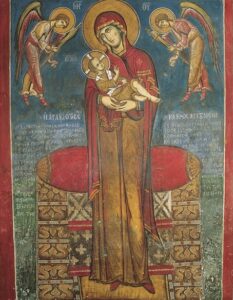 Ένας στίχος που εχαράχθη στην καρδία μου απόψε από το Απόδειπνο, το Μικρό Απόδειπνο, το οποίον είναι συνημμένο, ενωμένο μαζί με την ακολουθία των Χαιρετισμών και που ενδιαφέρει όλους μας και θα το βρούμε μπροστά μας όλοι μας. Οι περισσότεροι τουλάχιστον. Λέει, εκεί που ο διάκος ο καλλικέλαδος απόψε είπε το «Άσπιλε αμόλυντε… και εν τω καιρώ της εξόδου μου», λέει, «την αθλίαν μου ψυχήν περιέπουσα, και τας σκοτεινάς όψεις των πονηρών δαιμόνων πόρρω αυτής απελαύνουσα.»
Ένας στίχος που εχαράχθη στην καρδία μου απόψε από το Απόδειπνο, το Μικρό Απόδειπνο, το οποίον είναι συνημμένο, ενωμένο μαζί με την ακολουθία των Χαιρετισμών και που ενδιαφέρει όλους μας και θα το βρούμε μπροστά μας όλοι μας. Οι περισσότεροι τουλάχιστον. Λέει, εκεί που ο διάκος ο καλλικέλαδος απόψε είπε το «Άσπιλε αμόλυντε… και εν τω καιρώ της εξόδου μου», λέει, «την αθλίαν μου ψυχήν περιέπουσα, και τας σκοτεινάς όψεις των πονηρών δαιμόνων πόρρω αυτής απελαύνουσα.»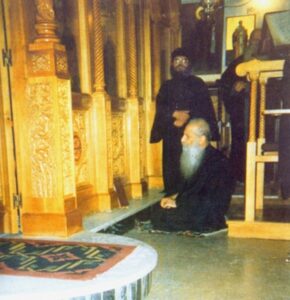 Ερωτήσαμε κάποτε, τον άγιο γέροντά μας Ιάκωβο της Εύβοιας, που αγιοκατατάχθηκε τελευταία επίσημα από το Οικουμενικό μας Πατριαρχείο:
Ερωτήσαμε κάποτε, τον άγιο γέροντά μας Ιάκωβο της Εύβοιας, που αγιοκατατάχθηκε τελευταία επίσημα από το Οικουμενικό μας Πατριαρχείο: 



